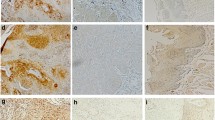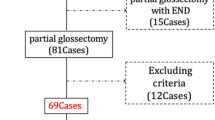Abstract
Purpose
Focal adhesion kinase (FAK) and Src are protein tyrosine kinases, localized in the focal adhesions, which, upon activation interacts each other, regulate several cellular signaling pathways implicated in malignant transformation and disease progression. The present study aimed to evaluate the clinical significance of FAK and Src protein expression in mobile tongue squamous cell carcinoma (SCC).
Methods
FAK and Src protein expression was assessed immunohistochemically on 48 mobile tongue SCC tissue samples and was analyzed in relation with clinicopathological characteristics, overall and disease-free patients’ survival.
Results
FAK positivity was noted in 32 (66.67 %) and Src positivity in 45 (93.75 %) out of 48 mobile tongue SCC cases. FAK and Src protein expression was significantly increased in well-differentiated tumors compared to poorly differentiated ones (p = 0.0455 and p = 0.0301, respectively). Mobile tongue SCC patients presenting elevated Src expression showed longer overall and disease-free survival (log-rank test, p = 0.0145 and p = 0.0388, respectively). In multivariate analysis, the depth of invasion proved to be an independent prognostic factor of both overall and disease-free patients’ survival (Cox regression, p = 0.0313 and p = 0.0481, respectively), whereas Src expression did not remain significant.
Conclusions
The present study supported evidence for a potential role of FAK and Src signaling in mobile tongue SCC, rendering their small-molecule tyrosine kinase inhibitors as possible treatment strategy in tongue cancer chemoprevention.


Similar content being viewed by others
References
Aleshin A, Finn RS (2010) SRC: a century of science brought to the clinic. Neoplasia 12:599–607
Barnes L, Eveson JW, Reichert P, Sidransky D (2005) World Health Organization classifications tumours. Lyon, IARC Press, Pathology and genetics of head and neck tumours
Ben-Izhak O, Cohen-Kaplan V, Nagler RM (2010) The prognostic role of phospho-Src family kinase analysis in tongue cancer. J Cancer Res Clin Oncol 136:27–34
Brandwein-Gensler M, Teixeira MS, Lewis CM et al (2005) Oral squamous cell carcinoma: histological risk assessment, but not margin status, is strongly predictive of local disease-free and overall survival. Am J Surg Pathol 29:167–178
Brenner H (2002) Long-term survival rates of cancer patients achieved by the end of the 20th century: a period analysis. Lancet 360:1131–1135
Canto MT, Devesa SS (2002) Oral cavity and pharynx cancer incidence in the United States, 1975–1988. Oral Oncol 38:610–617
Cao X, You QD, Li ZY et al (2008) Recent progress of SRC family kinase inhibitors as anticancer agents. Mini Rev Med Chem 8:1053–1063
Chatzizacharias NA, Kouraklis GP, Theocharis SE (2007) Focal adhesion kinase: a promising target for anticancer therapy. Expert Opin Ther Targets 11:1315–1328
Chatzizacharias NA, Kouraklis GP, Theocharis SE (2008) Clinical significance of FAK expression in human neoplasia. Histol Histopathol 23:629–650
Chatzizacharias NA, Giaginis C, Zizi-Serbetzoglou D et al (2010) Evaluation of the clinical significance of focal adhesion kinase and SRC expression in human pancreatic ductal adenocarcinoma. Pancreas 39:930–936
Chatzizacharias NA, Giaginis C, Gatzidou E et al (2011) Expression and clinical significance of FAK and Src proteins in human endometrial adenocarcinoma. Pathol Oncol Res 17:277–285
Chatzizacharias NA, Kouraklis GP, Giaginis CT et al. (2012) Clinical significance of Src expression and activity in human neoplasia. Histol Histopathol (in press)
Chen PN, Chu SC, Kuo WH et al (2011) Epigallocatechin-3 gallate inhibits invasion, epithelial-mesenchymal transition, and tumor growth in oral cancer cells. J Agric Food Chem 59:3836–3844
Cheng SJ, Kok SH, Lee JJ et al. (2011) Significant association of SRC protein expression with the progression, recurrence, and prognosis of oral squamous cell carcinoma in Taiwan. Head Neck (in press)
Cox BD, Natarajan M, Stettner MR et al (2006) New concepts regarding focal adhesion kinase promotion of cell migration and proliferation. J Cell Biochem 99:35–52
Duxbury MS, Ito H, Zinner MJ et al (2004) Inhibition of SRC tyrosine kinase impairs inherent and acquired gemcitabine resistance in human pancreatic adenocarcinoma cells. Clin Cancer Res 10:2307–2318
Finn RS, Bengala C, Ibrahim N, Roché H, Sparano J, Strauss LC, Fairchild J, Sy O, Goldstein LJ (2011) Dasatinib as a single agent in triple-negative breast cancer: results of an open-label phase 2 study. Clin Cancer Res 17:6905–6913
Golubovskaya VM (2010) Focal adhesion kinase as a cancer therapy target. Anticancer Agents Med Chem 10:735–741
Ho YT, Yang JS, Li TC et al (2009) Berberine suppresses in vitro migration and invasion of human SCC-4 tongue squamous cancer cells through the inhibitions of FAK, IKK, NF-kappaB, u-PA and MMP-2 and -9. Cancer Lett 279:155–162
Ilic D, Furuta Y, Kanazawa S et al (1995) Reduced cell motility and enhanced focal adhesion contact formation in cells from FAK-deficient mice. Nature 377:539–544
Ito H, Gardner-Thorpe J, Zinner MJ et al (2003) Inhibition of tyrosine kinase Src suppresses pancreatic cancer invasiveness. Surgery 134:221–226
Jemal A, Siegel R, Ward E, Murray T, Xu J, Thun MJ (2007) Cancer statistics. CA Cancer J Clin 57:43–66
Jiang H, Liu L, Ye J, Liu H, Xing S, Wu Y (2010) Focal adhesion kinase serves as a marker of cervical lymph node metastasis and is a potential therapeutic target in tongue cancer. J Cancer Res Clin Oncol 136:1295–1302
Kantola S, Parikka M, Jokinen K, Hyrynkangs K, Soini Y, Alho O-P, Salo T (2000) Prognostic factors in tongue cancer-relative importance of demographic, clinical and histopathological factors. Br J Cancer 83:614–619
Kim SA, Kwon SM, Kim JA et al (2011) 5′-Nitro-indirubinoxime, an indirubin derivative, suppresses metastatic ability of human head and neck cancer cells through the inhibition of Integrin β1/FAK/Akt signaling. Cancer Lett 306:197–204
Klijanienko J, el-Naggar AK, de Braud F et al (1995) Tumor vascularization, mitotic index, histopathologic grade, and DNA ploidy in the assessment of 114 head and neck squamous cell carcinomas. Cancer 75:1649–1656
Kopetz S, Shah AN, Gallick GE (2007) Src continues aging: current and future clinical directions. Clin Cancer Res 13:7232–7236
Laird AD, Cherrington JM (2003) Small molecule tyrosine kinase inhibitors: clinical development of anticancer agents. Expert Opin Investig Drugs 12:51–64
Li S, Kim M, Hu YL et al (1997) Fluid shear stress activation of focal adhesion kinase. Linking to mitogen-activated protein kinases. J Biol Chem 272:30455–30462
Lipfert L, Haimovich B, Schaller MD et al (1992) Integrin-dependent phosphorylation and activation of the protein tyrosine kinase pp125FAK in platelets. J Cell Biol 119:905–912
Michailidi C, Giaginis C, Stolakis V et al (2010) Evaluation of FAK and Src expression in human benign and malignant thyroid lesions. Pathol Oncol Res 16:97–107
Patel RS, Clark JR, Dirven R, Wyten R, Gao K, O’Brien CJ (2009) Prognostic factors in the surgical treatment of patients with oral carcinoma. ANZ J Surg 79:19–22
Po Wing Yen A, Lam KY, Wei WI et al (2000) A comparison of prognostic significance of tumor diameter, length, width, thickness area, volume and clinicopathological features of oral tongue carcinoma. Am J Surg 180:139–143
Po Wing Yen A, Lam KY, Lam LK et al (2002) Prognostic factors clinically stage I and II oral tongue carcinoma: a comparative study of stage, thickness, shape, growth pattern, invasive front malignancy grading, Martinez-Gimeno score and pathologic features. Head Neck 24:513–520
Rahimi N, Hung W, Tremblay E et al (1998) c-Src kinase activity is required for hepatocyte growth factor-induced motility and anchorage-independent growth of mammary carcinoma cells. J Biol Chem 273:33714–33721
Sano D, Myers JN (2007) Metastasis of squamous cell carcinoma of the oral tongue. Cancer Metastasis Rev 26:645–662
Sen B, Peng SH, Woods DM et al. (2011) STAT5A-mediated SOCS2 expression regulates Jak2 and STAT3 activity following c-Src inhibition in head and neck squamous carcinoma. Clin Cancer Res (in press)
Shiboski CH, Schmidt BL, Jordan RC (2005) Tongue and tonsil carcinoma: increasing trends in the U.S. population ages 20–44 years. Cancer 103:1843–1849
Shintani S, Matsura H, Hasegawa Y, Nakayama B, Fujimoto Y (1997) The relationship of shape of tumor invasion to depth of invasion and cervical lymph node metastasis in squamous cell carcinoma of the tongue. Oncology 54:463–467
Talamonti MS, Roh MS, Curley SA et al (1993) Increase in activity and level of pp60c-src in progressive stages of human colorectal cancer. J Clin Invest 91:53–60
Theocharis S, Klijanienko J, Giaginis C et al (2011) Expression of DNA repair proteins, MSH2, MLH1 and MGMT in mobile tongue squamous cell carcinoma: associations with clinicopathological parameters and patients survival. J Oral Med Pathol 40:218–226
Trarbach T, Schultheis B, Gauler TC et al. (2011) Phase I open-label study of cediranib, an oral inhibitor of VEGF signalling, in combination with the oral Src inhibitor saracatinib in patients with advanced solid tumours. Invest New Drugs (in press)
Verbeek BS, Vroom TM, Adriaansen-Slot SS et al (1996) c-Src protein expression is increased in human breast cancer. An immunohistochemical and biochemical analysis. J Pathol 180:383–388
Wangsa D, Ryott M, Avall-Lundquist E et al (2008) Ki-67 expression predicts locoregional recurrence in stage I oral tongue carcinoma. Br J Cancer 99:1121–1128
Xia J, Lv N, Hong Y et al (2009) Increased expression of focal adhesion kinase correlates with cellular proliferation and apoptosis during 4-nitroquinoline-l-oxide-induced rat tongue carcinogenesis. J Oral Pathol Med 38:524–529
Xing Z, Chen HC, Nowlen JK et al (1994) Direct interaction of v-Src with the focal adhesion kinase mediated by the Src SH2 domain. Mol Biol Cell 5:413–421
Xu LH, Yang X, Bradham CA et al (2000) The focal adhesion kinase suppresses transformation-associated, anchorage-independent apoptosis in human breast cancer cells. Involvement of death receptor-related signaling pathways. J Biol Chem 275:30597–30604
Zachary I (1997) Focal adhesion kinase. Int J Biochem Cell Biol 29:929–934
Zachary I, Sinnett-Smith J, Rozengurt E (1992) Bombesin, vasopressin, and endothelin stimulation of tyrosine phosphorylation in Swiss 3T3 cells. Identification of a novel tyrosine kinase as a major substrate. J Biol Chem 267:19031–19034
Conflict of interest
There are no conflict of interest among the authors.
Author information
Authors and Affiliations
Corresponding author
Rights and permissions
About this article
Cite this article
Theocharis, S., Klijanienko, J., Giaginis, C. et al. FAK and Src expression in mobile tongue squamous cell carcinoma: associations with clinicopathological parameters and patients survival. J Cancer Res Clin Oncol 138, 1369–1377 (2012). https://doi.org/10.1007/s00432-012-1215-1
Received:
Accepted:
Published:
Issue Date:
DOI: https://doi.org/10.1007/s00432-012-1215-1




